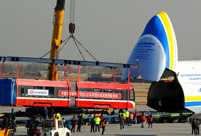 |
| China's lunar probe Chang'e-3, with the country's first moon rover onboard, landed on the moon, marking the first time that China has sent a spacecraft to soft land on the surface of an extraterrestrial body.(Xinhua/Li Xin) |
Lunar exploration has never stopped, and China still has a long way to go.
According to Yang Yuguang, researcher of the Second Academy of China Aerospace Science & Industry Corp, there have been two cycles of international lunar exploration. The first ran from 1958 to 1976. During the cold war the US and the Soviet Union engaged in a space science and technology battle focusing on lunar exploration. The US launched a total of 54 lunar probes in 7 successive series, and the Soviet Union launched 64 lunar probes in 4 successive series. All of these probes approached or landed on the moon, yielding fruitful results. In July 1967, Apollo 11 realized mankind’s dream of landing on the moon, the greatest success yet achieved in lunar exploration.
Some suggest that America and Russia have now put an end to their lunar exploration. But according to Yang Yuguang, this is not the complete picture.
In 1989, America’s declaration of its intention to return to the moon in the first decade of the 21st century triggered the second round of lunar exploration. “Lunar probes from the US are still orbiting the moon and collecting data, and only recently the US launched a new lunar probe. We can state that the US is still conducting lunar exploration,” says Yang. But since the late 1970s the Soviet Union has effectively ceased lunar exploration, as a result of two main considerations: the lack of clarity in its scientific targets during the cold war period when political aims were prioritized, and the lack of funds.
Now more countries and regions have begun lunar exploration. Japan, Europe, China and India have joined the lunar exploration club, and South Korea and other countries are also putting together plans for lunar exploration. The second round of lunar exploration resulted in 11 missions. Apart from 1 failure and 1 partial success, all the other missions succeeded. Compared with the first round, the success rate has seen a dramatic improvement, representing a big leap forward in exploration technology.
Yang Yuguang points out that China officially approved its own lunar exploration project early in 2004. Almost at the same time, the US and Europe also revealed their new space exploration plans. India also has officially announced its Chandrayaan lunar exploration plan. Lunar exploration is far from dead.
China’s deep space exploration has proved fruitful, but according to experts in the industry we still have a long way to go to match aerospace science powers like the US and Russia. While introducing the Chang’e-3 missions, Wu Zhijian, spokesman for the State Administration of Science, Technology and Industry for National Defence, acknowledged that China is still catching up in terms of factors like power, components, and materials.
 Heavy cargo flights taking off
Heavy cargo flights taking off In pictures: PLA's digital equipment
In pictures: PLA's digital equipment  Americans mark Thanksgiving Day with parades
Americans mark Thanksgiving Day with parades Love searching stories in cities
Love searching stories in cities  Shanghai shrouded in heavy fog
Shanghai shrouded in heavy fog Office ladies receive ‘devil’ training in mud
Office ladies receive ‘devil’ training in mud Changes in Chinese dancing culture
Changes in Chinese dancing culture  Highlight of Mr Bodybuilding and Miss Bikini Contest
Highlight of Mr Bodybuilding and Miss Bikini Contest  Picturesque scenery of Huanglong, NW China
Picturesque scenery of Huanglong, NW China 17th joint patrol of Mekong River to start
17th joint patrol of Mekong River to start The islands where immortals lived
The islands where immortals lived Snowstorms cause chaos for travelers
Snowstorms cause chaos for travelers Special police detachment of Hefei
Special police detachment of Hefei  Weekly Sports Photos
Weekly Sports Photos China's moon rover, lander
China's moon rover, landerDay|Week|Month